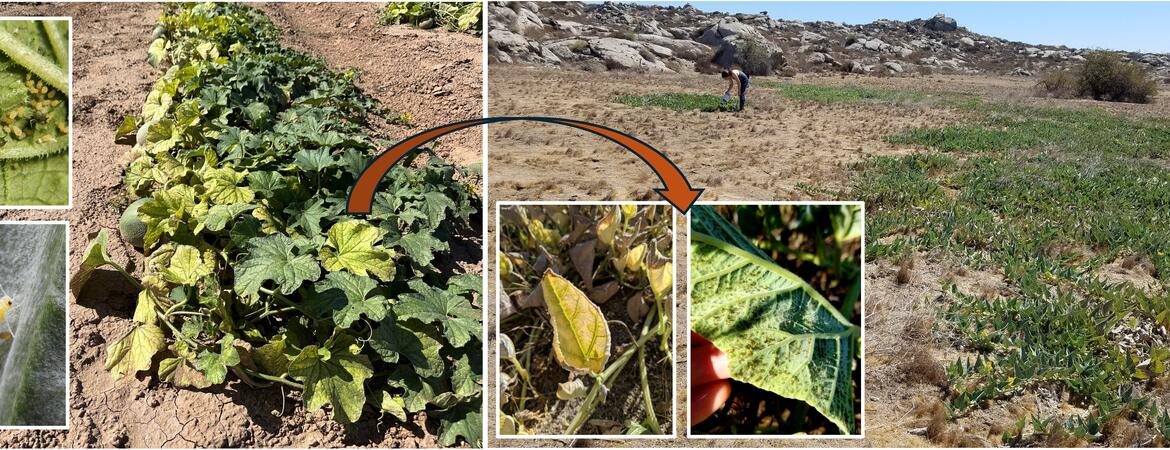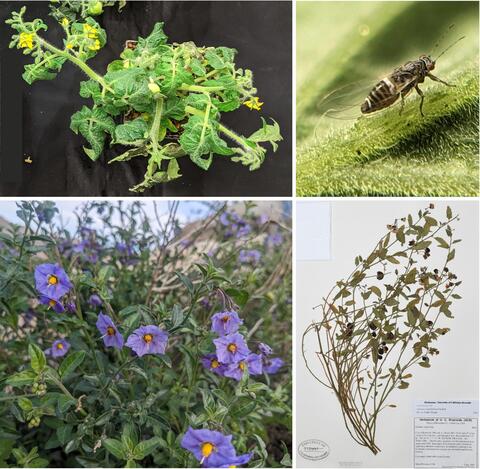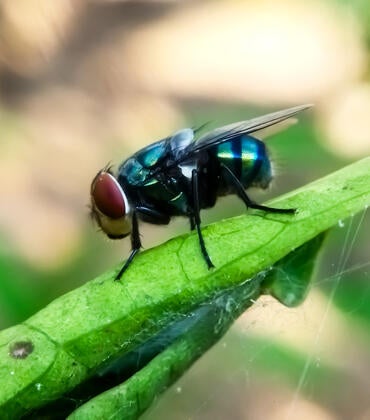
Native plants and non-native crops do not fare well in proximity to one another, attracting pests that spread diseases in both directions, according to two new UC Riverside studies.
“We have changed the landscape, and it’s created opportunities for pathogens to thrive,” said UCR entomologist Kerry Mauck, who co-authored the studies. “We have introduced pathogens that damage native plants, and on the other side of the coin we have endemic pathogens that mutate to infect crops.”
Illustrating the latter scenario, a new paper in the journal Phytopathology documents the presence in wild California plants of a bacterial pathogen affecting nightshade plants like tomatoes, potatoes, and peppers.
The pathogen, Candidatus liberibacter solanacearum or CLso, is related to the pathogen that causes citrus greening disease, a disease that kills citrus plants and for which there is no cure. Like citrus greening, CLso is transmitted to plants by a small flying insect called a psyllid.
CLso causes a potato disease called zebra chip which deforms the tubers, making them unmarketable and reducing crop yields by up to 90%. It first appeared in the 2000s and quickly spread throughout the country.
“We wanted to know, why did this thing show up so suddenly in the U.S.? The psyllid vector has been here. It’s native. We wondered if maybe the pathogen has also been here longer than we realized,” Mauck said.
To answer this question, the research team visited various UC natural reserves, a network of wildland areas managed for academic use. They took samples of plants in the nightshade family from each location they visited, and also looked at preserved herbarium specimens dating back to the 1970s.
The pathogen was present in 15-20% of the plants they examined, but the forms of it they found are not known to infect crops. Furthermore, the wild form of the pathogen isn’t known to harm the plants it inhabits. However, the form that affects crops does cause disease.
In other words, the CLso variants found in wild plant communities are not spilling over into agricultural fields. The researchers recently received funding from the U.S. Department of Agriculture to understand on a molecular level what changed as the pathogen mutated to be able to infect crop plants.
“What has changed to make this pathogen emerge as problematic? What proteins are different in the benign and virulent variants? What do they interact with in the plant? If we learn the answers to these questions, we can understand how plants resist the disease, and help them,” Mauck said.
In a related study published in the Phytobiomes Journal, Mauck and colleagues examined the possible movement of viral pathogens from agricultural fields to wild squash plants in the UC reserves.
“Crops such as squash, melons, and potatoes attract aphids and whiteflies that can spread viruses from crops to wild plants,” Mauck said.
“A lot of the viruses in crops are very new to the area, being introduced only in the last couple of decades. If these viruses are moving out of crops and into wild areas, the native plants could be bombarded with new pathogens they’ve never encountered before.”
For this project, the researchers again sampled plants from the UC reserves as well as Anza-Borrego Desert State Park. Fully 80% of the wild squash plants they sampled were infected with a virus that is not native to California called cucurbit aphid-borne yellows virus, or CABYV.
When the researchers studied these viral infections, they found that CABYV inhibits the growth of plant roots — a problem for environments that are especially dry and hot in summer like Southern California.
“If the plants can’t make roots, they can’t access groundwater or store water in their roots. And wild squash are among the few plant species growing and providing resources in summer, so they’re relied on a lot by other organisms,” Mauck said. “They’re highways for ants. They provide nectar and pollen. The seeds are eaten by endangered mammals. They’re critical.”
The researchers feel both studies underscore the importance of land managers, growers, and plant enthusiasts working together to reduce the introduction of plant pathogens to new spaces.
“Plant pathogens can be anywhere. Whenever we move plants for trade, there is the potential for bringing in pathogen hitchhikers as well. We need to make sure we’re moving only plant material that doesn’t contain these unwanted guests,” Mauck said.
“Studying how plant pathogens move, live together in plants, and mutate over time can help us to achieve the goal of reducing unwanted pathogen problems both in crops and in wild plants.”





